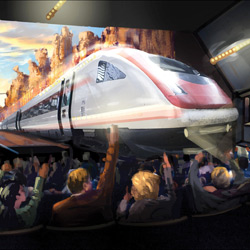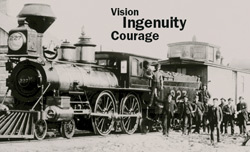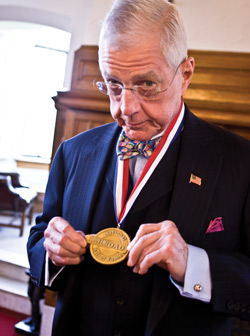
The stories of the people and machines that shaped the western world.
Peoria-area residents are well acquainted with the planned Peoria Riverfront Museum and Caterpillar Visitors Center that will draw tourists to the city’s waterfront. But the community may not be as familiar with Engines of Freedom, a rail-themed destination attraction in the planning stages in neighboring Galesburg. The combined power of these sites promises a synergy that is bound to boost tourism in the entire west-central Illinois region.
Drawing on its Heritage
From the arrival of the first train in 1854, Galesburg has been passionate about railroads. The community boasts one of the country’s largest rail classification yards, and freight traffic through town often surpasses 120 trains per day. In 2003, to honor this rich railroad heritage, community leaders sought and received resolutions of the U.S. Congress designating Galesburg as the home of the National Railroad Hall of Fame (NRHF). Annual inductions began in 2003, with 34 individuals recognized to date.
“It doesn’t take long to realize that the life accomplishments of our inductees tell the story of the building of America,” says NRHF Founder and President Emeritus Bob Bondi. “For our board, the natural next step was to create an inspiring destination attraction celebrating the railroad industry’s legacy.”
A Thoroughly Modern Facility
“We didn’t want a lot of artifacts in glass cases.” That’s how Board Chair Jay Matson describes the organization’s approach. “Our board toured the Abraham Lincoln Presidential Museum in Springfield shortly after it opened in 2004, and we all had the same reaction: ‘That’s it! That’s the type of facility we want to create!’”
After a national search, the NRHF Board engaged the Lincoln Museum design firm, BRC Imagination Arts of Burbank, California, to craft its own concept vision. BRC founder Bob Rogers got his start designing exhibits for Disney at Epcot Center, and has received two Academy Award nominations in the technical field. “They are masters of the high-tech, interactive approach necessary to attract a modern audience,” says Matson.
The selection of BRC is consistent with a core NRHF objective: to create a high-caliber institution with a nationwide reach. At each stage of the facility’s development, organizers have engaged highly acclaimed creative talent and expert professional advisors to ensure a visitor experience that is second to none.
To create that appeal at Engines of Freedom, the visitor experience will be story-driven, immersive and cinematic in approach. It will combine impeccable scholarship with exquisite showmanship for an experience that is at once educational and fun. Excitement will be generated by high-tech and interactive exhibits such as simulators, computer games, holograms, touch screens, digital maps, living murals and theatrical illusions. Learning will feel like entertainment.
An Attraction Like No Other
Engines of Freedom will be unique among railroad attractions in several key respects. The first is the facility’s proximity to live train traffic. “Our planned location in downtown Galesburg, adjacent to the main line, will make us one of the only major rail attractions in the nation to offer the excitement of live freight rail traffic right outside the window,” says Matson.
In addition, Galesburg’s Amtrak passenger depot will adjoin Engines of Freedom, allowing the facility to be served by both regional and long-distance passenger service. An enclosed rooftop platform will afford year-round, birds-eye viewing of live switching action in one of the country’s largest Class I rail yards.
Another of the project’s defining characteristics is its interpretive approach to the railroad story. “The vast majority of railroad museums across the country are built around collections,” says the NRHF’s Matson. Engines of Freedom will take an interpretive approach, telling the epic railroad story in the context of the greater economic, social and political events in our nation’s history. The story line will showcase the transformative impact of the industry in building the nation and shaping the life of each American today.
The Great American Story
Each section of the Engines of Freedom experience will present a different element of the nation’s railroad story, with a unique feeling and message.
Grand Central Hall. Visitors will enter a grand Central Hall reminiscent of the iconic railroad station concourses that resonate in American cultural memory. It will serve as a gateway, with portals leading to the theater and galleries. A large, beautiful mural centered high on the far wall will offer a pictorial history of railroading in one centralized presentation. A show unto itself, the mural will periodically animate, immersing visitors in the sights, sounds and smells of trains.
“Building the Engines of Freedom” Theater. The theater presentation will celebrate the grand sweep of the railroad industry by showcasing major events in the development of the U.S. rail network. The cinematic overview will feature six screens, dynamic visuals, 360-degree sound, seats that simulate live action, and in-theater effects like rain, wind and snow, giving visitors a visceral sense of being in the middle of the action.
“Spirit of the Railroaders” Galleries. Three galleries will form the heart of the visitor experience. Focusing on the human element, each gallery will highlight a key inspirational quality of railroaders and provide a direct link to NRHF inductees.
 The Vision Gallery will focus on the dreamers, visionaries and dare-takers of the industry. It will celebrate the accomplishments of railroaders on the grandest scale, evoking triumphant, expansive feelings characteristic of the indomitable American spirit.
The Vision Gallery will focus on the dreamers, visionaries and dare-takers of the industry. It will celebrate the accomplishments of railroaders on the grandest scale, evoking triumphant, expansive feelings characteristic of the indomitable American spirit.
The Ingenuity Gallery will tell the story of hardware, technology and power. Beginning with the advent of steam power, it will explore the amazing variety of technological advancements developed by railroads through the decades, inspiring awe and admiration for the creative power of the engineers and inventors who built and advanced the nation’s railroad system.
The Courage Gallery will focus on the bravery and sacrifice of laborers and immigrants who built the railroads—the vast majority of whom were ordinary people whose names we will never know. The feeling of this gallery is raw, gritty and intense, as people and machines conquer seemingly insurmountable challenges.
Railroads in Arts and Culture. The facility would not be complete without a sampling of the music, art, film, photography and other creative works that railroads have inspired. This gallery will offer a treat for the senses and will be all about appreciation and enjoyment. Visitors will recognize that railroads are inextricably woven into the fabric of our society and culture, a part of what makes us who we are as Americans.
National Significance, Regional Impact
When it comes to economic impact, there is power in numbers. “As our facility takes shape,” says Matson, “we plan to explore partnerships with other area attractions to boost visitation for the entire region.” Joint programming, tourism corridor linkages, coordinated marketing, and unified branding are just some of the ways in which Engines of Freedom might connect with other attractions to enhance visitation and economic development.
Matson believes the region is particularly well positioned to capture a piece of the heritage tourism market, one of the fastest growing segments of the tourism industry. In addition to Peoria’s Caterpillar Visitor Center and Galesburg’s Engines of Freedom, area sites of national importance include the Abraham Lincoln Presidential Museum in Springfield, the John Deere Pavilion in Moline, and the Lincoln-Douglas debate site at Knox College in Galesburg.
As the NRHF’s Matson puts it, “This is an amazing confluence—the stories of the people and machines that shaped the western world—right here in our backyard.” iBi
 » Honoring the Legends Who Built a Nation
» Honoring the Legends Who Built a Nation
To honor the railroaders who transformed the nation, the National Railroad Hall of Fame annually inducts worthy individuals in the history and contemporary operation of railroads. Honorees may be visionaries, leaders and trendsetters of the industry, or ordinary people who made extraordinary contributions. The power of their stories is at the heart of the National Railroad Hall of Fame.
Inductions are made in three categories: Birth and Development Era (1800 to 1865), Golden Era (1866 to 1945) and Modern Era (1946 to present). Induction ceremonies are held at Knox College on the last Saturday in June, to coincide with the Railroad Days Festival. Ceremonies are free and open to the public.
Do you have a favorite figure in rail history? Nomination forms are available at nrrhof.org. For more information on the Railroad Days Festival, visit galesburgrailroaddays.org.

